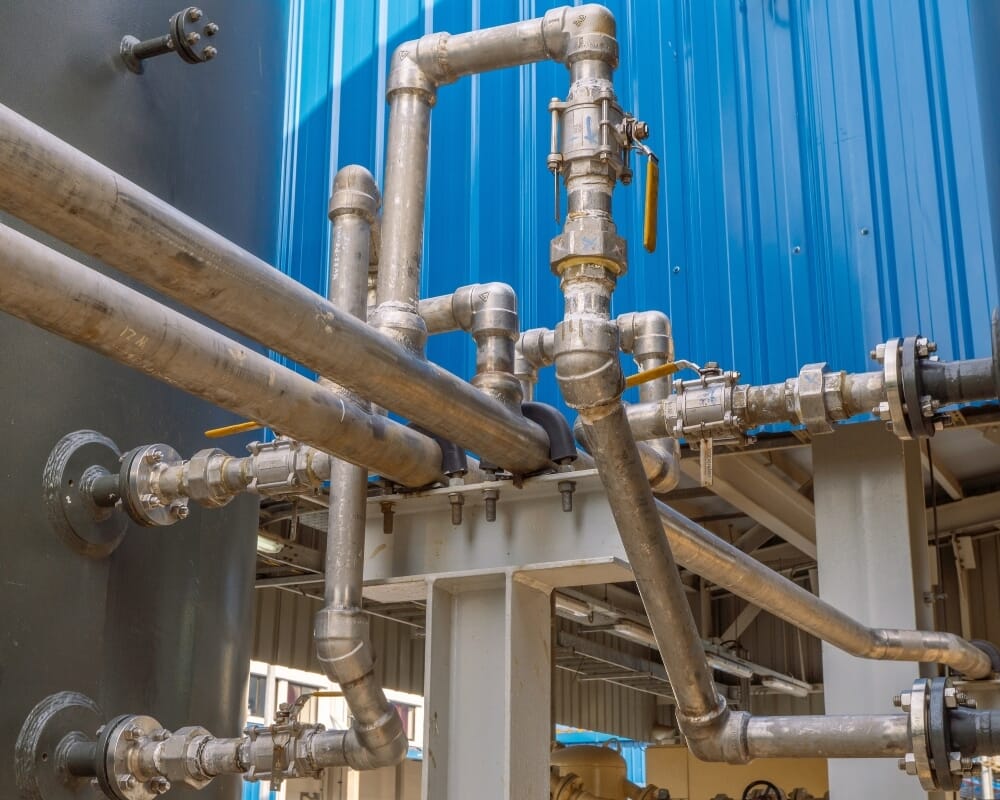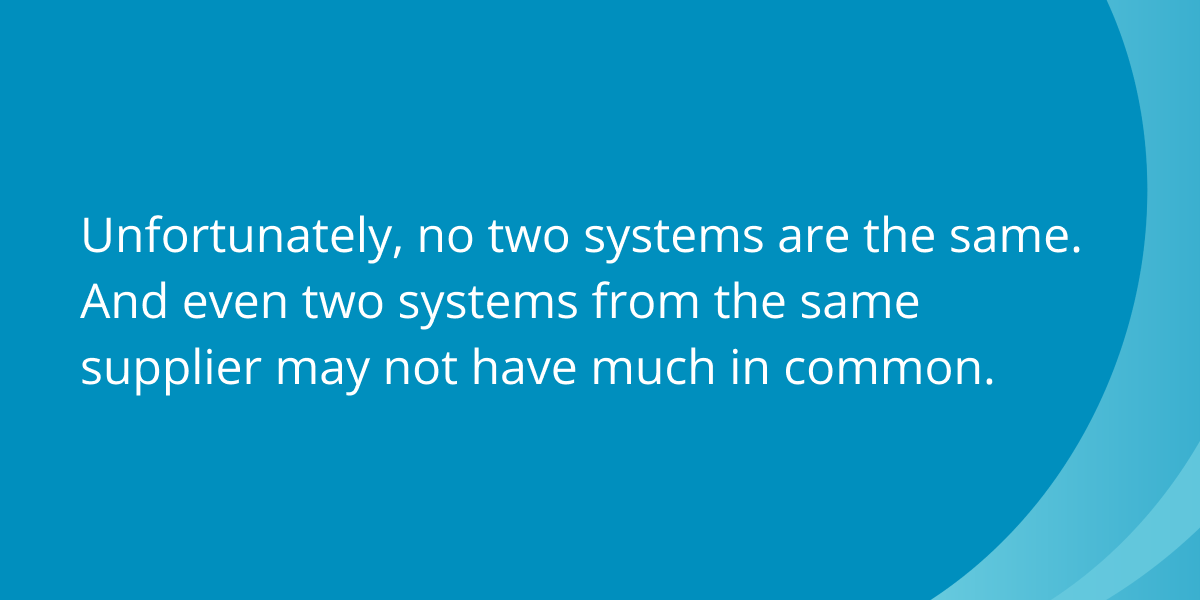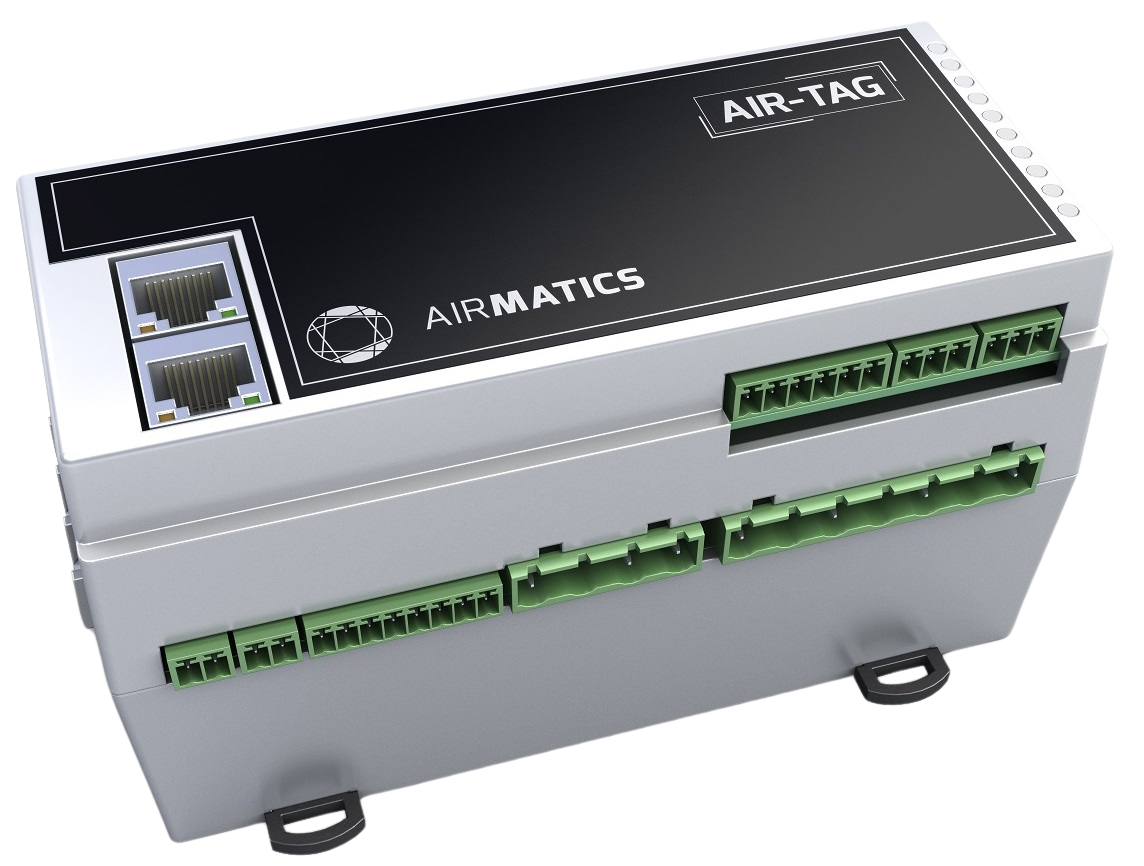
Six Air Compressor Reliability Tips That Boost Uptime and Equipment Life
October 15, 2025
Five Questions You Need to Answer to Get Compressed Air Header Pressure Right
October 29, 2025What You Need to Know about Air Compressor BMS Integration
Kaishan USA | October 22, 2025 | Uncategorized

Integrating your air compressor with your building management or factory automation system can enable you to save money, reduce downtime and improve performance and reliability.
Today’s factory communications encompass a wide range of systems, techniques, software and even philosophies that interconnect all levels of a manufacturing enterprise.
This buffet of different approaches, opinions and choices all strive to link the systems and processes in your facility, allowing them to talk to each other.
These various tools and their acronyms include:
- Building management systems (BMS) manage much of a building’s physical infrastructure, including lighting, security and heating, ventilation and air conditioning systems.
- Building automation systems (BAS) are almost the same as BMS, but focus primarily on automating systems such as HVAC and lighting.
- Building automation and control network (BACNet) is the communications protocol used by BMS.
- Supervisory control and data acquisition (SCADA) systems control equipment at a very high level.
- Enterprise resource planning systems (ERP) integrate many of a company’s administrative functions, such as inventory control and finance.
The landscape is further complicated by conceptual approaches such as the Industrial Internet of Things (IIoT), Industry 4.0 and smart factory initiatives.
Individual enterprises may have some or all of these systems in place. Unfortunately, no two systems are the same. And even two systems from the same supplier may not have much in common.

Basically, they’re all in the business of communications—capturing, preserving and passing along critical information. Giving people at all levels of your organization access to critical data that will enable them to take action.
For purposes of simplicity, we’ll use air compressor BMS integration as a general term to describe how your air compressors, whether centrifugal air compressors or rotary screw compressors, tie into broader information management systems.
The Benefits of BMS Integration
There are many good reasons to integrate your compressed air system into a building management or factory automation system:
- Save money. Optimize your system, cut downtime, increase equipment life and create a safer environment for your team. All those things pay off financially.
- Cut downtime. Maintain your system to its highest level of performance, optimize operations and avoid costly breakdowns that damage equipment and shut down your plant.
- Improve reliability. Improve the operation of your air compressor and all related equipment, including filters, dryers and coolers. Schedule preventive maintenance before an issue becomes a problem.
- Optimize performance. Tweak system operation and ensure everything runs according to design.
- Extend equipment life. Identify equipment issues such as rapid cycling. Or receive an alert when oil changes and oil sampling are required, or your compressor is not operating within its design parameters.
- Enhance safety. Receive alerts about equipment issues well before they reach a critical point. And avoid accidents that result in damage, lost production and even injuries to your staff.
A previous blog post, “Twelve Reasons Why You Should Be Monitoring Air Compressor Data,” provides more detail on the benefits of capturing, analyzing and applying the insights from air compressor data.
The bad news is that capturing and using that data takes some effort. The good news is that we’ve advanced well beyond the stage where data collection is manual. And the process doesn’t necessarily involve a lot of expense or difficulty.
So what’s the best way to proceed? It all depends on what you are looking for.

Most air compressor system monitoring systems allow 24/7 remote access to air compressor data, even from your home office.
What Do You Want from an Air Compressor BMS Integration?
The key issue is, what do you want to accomplish?
Do You Want To Manage Something?
Do you hope to be able to control your entire compressed air system, for example, choosing which compressor is operating and which one is shut down?
Or Do You Just Want To View the Data?
Are you simply looking to capture and view the data?
It may depend on the size of the plant, with larger plants choosing to have greater control.
But, at the very least, we recommend that our customers view the data. Here’s why:
- It’s valuable information. As mentioned above, analyzing the data in your system can save you time and money. Plus, your service provider may change. Or your maintenance technician may go on vacation or leave the company. Both are good reasons why that data may come in handy.
- It’s become easier. It’s simpler to capture and view that data than it used to be. And there doesn’t have to be any security threat or major IT involvement.

Integrating with a BMS: What Do You Need To Do
Because there are so many different forms of communications and types of systems, it’s not practical for a manufacturer to offer all of them. As a result, manufacturers select the communications protocols they support and build those protocols into their products.
The most important thing we can do is ensure that you understand which protocols we support.
Additionally, most local compressed air consultants are in the same boat. They know compressed air but are not building management system experts. So they are in the same position as manufacturers: it’s unlikely they’ll have expertise in the specific BMS your company is using.
We find that most customers have either an in-house specialist or a consultant/expert who knows your BMS and can easily tie a new machine into it.
As a result, the customer usually knows their system and doesn’t need support from the compressor manufacturer or their compressed air consultant.
What you do need to know:
- What your system requires
- How a product communicates.
- How you can integrate it into your system.
If your system does not accept the communications protocol a product uses, you may still be able to convert the data into a form it can use.
How Kaishan Compressors Communicate
There are three main ways to capture the data your air compressor is generating:
- Basic air compressor system monitoring. At the simplest level, you can pull alarms and warnings off your compressor controller to track system pressure. The cost is small, and the demands on your IT department are minimal.
- Modbus remote monitoring and controls. You can also connect the parts of your air compressor system, including compressors, dryers and other equipment, using a Modbus interface. Modbus is a communications protocol widely used in industrial settings to exchange data between devices. It is brand-agnostic, creating a standard, low-cost data format to link equipment from different manufacturers.
- AirWatch. Our most advanced connection is through our AirWatch system, which uses a wireless-based cellular modem to enable real-time air compressor system monitoring through any connected device, including desktops and cell phones.
Our AirWatch system communicates through a cellular connection and thus does not require crossover into your system. It digitally creates a twin online using the Modbus protocol to display pressure, temperature, faults, status and other key indicators, alerting you that it’s time to replace components showing wear. Before they begin to fail.
The wireless approach avoids the nightmare of going through your IT department, enterprise software system and factory automation infrastructure.
AirWatch gives you 24/7 remote access to your air compressor data, tracking system performance and identifying readings that are out of spec. So you can fix problems before they start.
Plus, you can get alerts when your pressure drops, electricity consumption rises too rapidly or air quality begins to deteriorate. Giving you time to take corrective action. Logging trends helps identify anomalies such as excessive leaks or misuse of pneumatic equipment.
With AirWatch, you can customize alerts and format trend analysis according to your preferences. You can even give your local distributor or air compressor professional access to the system, allowing them to respond if needed.

The AirWatch base unit is available on our KRSD, KRSP, KRSP2, KRSL and KROF two-stage, oil-free rotary screw air compressors and our KRSV rotary screw vacuum pump.
For more information on advanced control technologies, read our blog post, “The Future of Energy Efficient Manufacturing: Rotary Screw Air Compressors.”
Because the connection is an isolated unit communicating via cellular, there’s no threat of a security breach.
A Case Study
We’ve seen many instances where remote monitoring of air compressors produces benefits.
One example: A customer consistently faced a recurring problem—almost like clockwork, they had to replace the bearings in their compressor every year.
To identify the cause, they integrated an online visual reference into the system.
When they pulled up the data, they discovered that something had changed on the third shift—their machine was running unloaded, accumulating water.
Previously, the compressor had been set to shut down when it wasn’t needed, so it didn’t run unloaded. But apparently, someone had changed a setting,
The company revised the settings, enabling the compressor to shut off when demand dropped.
The results? No running unloaded. No water buildup. No bearing failure. And significant savings in energy and electrical costs.
Help with Air Compressor BMS Integration
Once again, we recommend that our customers get online maintenance checks and online visualization.
That way, you will at least be able to capture and view your data, storing it over time. You may well find that historical information invaluable. You won’t need to build in a lot of checks and balances to find out that something is wrong.
And you’ll also want to allow your compressed air consultants to access your data, giving them a head start if you run into a problem.
The bottom line: Integrating your air compressor into a building management system or other enterprise-wide communications system is not as expensive or complex as you may think. You can do a small compressor at a paint and body shop or five or six machines at a pharmaceutical plant. Whatever you need, there’s a system for you.
That said, manufacturers and local compressed air consultants usually are not experts in system integration. But we can help by ensuring that you know how our compressors communicate. So that you can determine if your system will recognize that data.

Your compressed air consultant may not be able to integrate your compressor into your BMS, but they can ensure you know how your compressor can communicate with your system.
We work with a nationwide network of independent distributors, who can provide on-site help and consultation as needed. These factory-trained air compression experts can help you find the best air compressor monitoring approach for your application.
We partner with independent, local distributors because it's the best way to serve you. Unlike large corporate suppliers, there's no red tape here; our distributors offer expert guidance, faster response times and personalized support tailored to your needs. They don't just sell compressors—they build relationships, ensuring you get the right system, reliable service and quick access to parts when you need them most.
With factory-trained technicians and a deep understanding of industrial applications, they help maximize efficiency and minimize downtime. So, when you buy through Kaishan, you're getting more than a product—you're getting a local partner who cares about your business and wants to see it succeed.
Key Takeaways
- There are many different types of communications approaches in use, including BMS, BAS, BacNet, SCADA and ERP systems.
- Air compressor BMS integration can help save money, prevent downtime and improve reliability, allowing you to monitor your system remotely.
- The key decision is whether you want to control your compressor remotely or simply view the data.
- We recommend that you at least view the data, because it’s valuable information and is easier than ever to access.
- To successfully integrate your compressor into a BMS, you need to know what the system requires and how your compressor communicates.
- Our AirWatch system gives you real-time monitoring of your air compressor data through any connected device.
Let Us Help
Air compressor BMS integration offers many benefits for the operation of your compressed air system and all the processes that rely on it. If you need help integrating your rotary screw air compressor or centrifugal compressor into your building management or factory automation system, contact the experts at Kaishan. Contact us today.
Listen to the Podcast Version
Understanding BMS Integration in Industrial Settings
Alright, welcome back to The Big Dog Podcast! I’m Lisa Saunders, and as always, I’ve got Jason Reed right here. Today, we’re gonna tackle something a lot of plants talk about but almost nobody seems eager to untangle—air compressor integration with building management systems, or BMS. And not just BMS, but all the factory weird alphabet soup: BAS, BAC Net, SCADA, ERP… You know, the whole communications jungle.Yeah, and you know what? It’s wild out there, Lisa. Every facility I walk onto has this mix of systems—BMS taking care of all the building stuff, lighting, climate control, maybe even security. BAS is almost the same thing, mostly just focused on automating stuff like lighting and HVAC. Then you’ve got SCADA sitting above that, controlling equipment big-picture style. Not to mention ERP, which is more about inventory and accounting, keeping the business wheels spinning.
Right. But here’s the kicker: even two systems from the same supplier barely talk to each other sometimes. Everyone’s got their own flavor of “integration.” When I was at my last gig, we tried to pull compressor data into this ancient BMS. But nothing worked, none of the protocols matched. We were kinda stuck until, honestly, we sat down and just mapped out exactly what each system was talking—what protocol, what data, and who needed to see it. Once we figured all that out, it was like, “Duh, this is what was missing the whole time.” And then, of course, that opened this floodgate of upgrades across the facility. Yeah, the dreaded ‘domino effect’—but in a good way.
That’s classic. Everyone wants the systems to “just work together,” but getting ‘em to play nice? Different beast. And look, most of these setups, it’s not just one person’s job. You’ve got IT folks, operators, and usually some third-party consultant who knows the BMS inside out but maybe doesn’t touch compressors at all. So it turns into a team sport, right?
Exactly. So when we say “air compressor BMS integration,” we’re really just talking about plugging your compressors—rotary screw, centrifugal, whatever—into these broader plant systems. But what that looks like is gonna depend completely on what you’ve already got in your facility, and who needs what data. It’s less about some magical solution and more about knowing all these different moving pieces actually speak different languages.
Benefits of Air Compressor System Monitoring
Alright, so let’s dig into why anyone should care. What’s in it for the plant if you go through the trouble of tying your compressors into all these systems? Well, first off—cost savings. That’s the big carrot. The more you optimize, the less you’re paying in energy bills. It’s not just about the equipment running, it’s about running smart. And you’re also cutting downtime because those little warning signs actually get picked up early. And you, uh, you live longer, at least in compressor years.You’re not wrong. Integrating compressors means you catch issues before you’re knee-deep in an unplanned shutdown. It gives you a heads-up to maintenance—like when your filters or dryers are slipping, or when you’re getting too many rapid cycles. Scheduled maintenance gets way easier. And seriously, even if all you’re doing is just pulling alarms or warning data off the controller, that’s already a game-changer for most teams.
Yeah, totally. And then, if you move up to advanced options, like Kaishan’s AirWatch, you get real-time monitoring. That means 24/7 remote data access—like, you’re sitting at home and your phone buzzes because the pressure dropped or the system started pulling too much power. AirWatch uses a cellular modem, so there’s no jumping through your IT department’s crazy firewall hoops. Plus, no crossover with plant network stuff, so you skip a bunch of security headaches.
Right, and with AirWatch, you can customize which alerts you get, how you get trend reports, all that. And another thing—the ability to let your distributor or compressor tech take a peek at your system remotely? That’s a huge time saver if something looks off. Actually, didn’t you have a customer story about that kind of remote troubleshooting?
Yeah, I did. So, we had one customer who, like clockwork, would have to replace the compressor bearings every single year. It got to the point where it was just built into their budget, which is…not what you want, obviously. Once we got real data online and could see what was happening, turns out, there was a setting changed during third shift. The compressor was running unloaded and just building up water—nothing you’d spot unless you had that monitoring. Got the settings right and all those bearing failures just disappeared. That save paid for the monitoring system ten times over.
I love stories like that—the kind of “hidden in plain sight” issues you’re never gonna catch just walking the floor. And honestly, with how easy it’s gotten to at least capture and view compressor data, there’s no excuse not to do it now. Even if you don’t want full control, getting those numbers in front of people is pure gold.
How to Make BMS Integration Work For You
So, let’s say you’re ready to pull the trigger on this—what does it take to actually make BMS integration work in your plant? First step is figuring out what your system needs, plain and simple. Does your BMS want Modbus, BACNet, something else? What kind of monitoring does your team need to see—just alarms, or full-blown analytics with trend graphs and alerts?Right, and most compressor manufacturers, Kaishan included, can’t support every protocol on the planet. It’s not realistic. You need to know how your new compressor talks, whether it’s got basic alarm outputs, a Modbus port, or something more advanced like AirWatch. If your existing BMS doesn’t take those directly, there’s usually a way to convert, but it helps to plan that up front—otherwise you end up with a shiny new compressor that just sits there mute while the rest of the facility’s chatting away.
Oh, totally. The biggest question I get from folks is, “Should I be able to control my compressor from my desk, or do I just want to watch the data?” That’s where it gets real. For a lot of smaller shops, just viewing the data is more than enough. But if you’re running a big operation, you might want to switch compressors or shut stuff down remotely. Whatever your answer, at least be sure you can access and store your data. Having that history is a real-life saver, especially when people leave or techs rotate out.
And, look, let’s be honest—not every plant has a bunch of in-house system integration nerds, right? That’s where local experts really come in clutch. Kaishan partners with a network of independent distributors, and this is honestly where the gold is. You’re not dealing with megacorporate red tape—you’re working with folks who know the equipment, your process, your region, all that. You get way better support, quicker help, and somebody who’s actually invested in your uptime.
Yeah, and they’re not just handing you a compressor and walking away. They’re building relationships, making sure you get the right monitoring tech—and if you ever do want to step up or pivot your integration, they’re right there. It beats waiting on hold for corporate tech support in another time zone, I’ll tell you that much.
So just to bring it home, you don’t have to reinvent the wheel here. Figure out what your system supports, what info you actually need, and partner up with someone who’s gonna walk the road with you—not just drop a box at your door. That’s how you get the most out of BMS integration—and how you hold on to your sanity when stuff inevitably changes down the line.
Alright, that’s a wrap for today. If you’ve got integration projects on the horizon, or just wanna see what your options are, Kaishan’s local network is a good place to start. Jason, thanks as always for keeping it real.
Of course—always a pleasure, Lisa. And to everyone listening, take care of your air, and we’ll be back soon with more no-nonsense breakdowns. See ya next time.
Catch you all on the next episode of The Big Dog Podcast. Bye, Jason! Bye everyone!
Random stat or
customer quote
textXXtext
text

